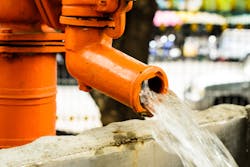In the November 2015 issue of Water Technology, Andrey Mitchenko of ECOSOFT wrote about a single process that removes five contaminants from groundwater. This system can be a useful tool for the 15 percent of Americans who receive drinking water from private wells, which can have varying mineral content.
Mitchenko noted that the five major well water problems are hardness, iron, manganese, tannins and ammonium. A multistage process that includes catalytic media, ion exchange for softening, activated carbon and an adsorbent can be reduced to a simpler method that involves a softening material that contains five active components, each of which has a unique function — oxidation-adsorption of iron and manganese, retention of tannins, and hardness and ammonium removal.
The components’ surface chemistry allows for effective treatment because of two key factors:
- A copolymer with a surface where charged and complexation groups are immobilized. It binds manganese and iron ions.
- The second binds natural organics and releases them during regeneration.
Mitchenko presented three field tests that demonstrate the system’s effectiveness, one of which shows how it yielded a 96 percent tannin rejection along with iron removal and softening on an Okeechobee, Florida, ranch.
Other field tests revealed how raw water in Deerfield and Madison, Wisconsin, was treated for hardness, iron, tannins and manganese.
When considering which approach to use, water treatment professionals can compare the new approach to the traditional one, which Mitchenko claimed to be more expensive and more complicated in general.
Read the full article here.
